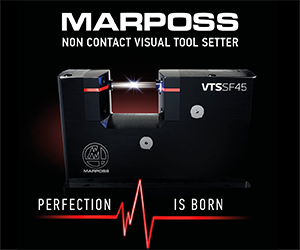Look Into My Stylii: Care Of Surface Finish Contacts
Proper care of contact points is one of the basic considerations in gaging. Whether you're using a simple indicator gage or a sophisticated surface finish instrument, much depends on the condition of the sensitive contact point, which is the interface between the gage and the workpiece.
Proper care of contact points is one of the basic considerations in gaging. Whether you're using a simple indicator gage or a sophisticated surface finish instrument, much depends on the condition of the sensitive contact point, which is the interface between the gage and the workpiece.
Dial indicator contacts are easy to inspect. They're big enough to get your fingers around, and you can check them visually for wear, damage, or contamination.
The tiny contacts on surface finish gages are quite another matter. Compared to blunt dial indicator contacts, a surface finish gage has a fine "stylus" point, enabling it to follow the texture of the surface, but being of a form and dimension so as to avoid scratching the part. Gaging force from a dial indicator is typically 120 grams/1.2 N; in contrast, force from a surface finish gage is light, usually between 100 mg and 1500 mg ( 1 mN to 15 mN). But because the stylus is "dragged" across the surface of the workpiece, it is just as subject to wear and damage as a dial indicator contact.
Surface finish contacts are made of diamond, and are conical in form, having a 60-degree or 90-degree included angle and a spherical vertex with a radius of 0.0004-inch, 0.0002-inch, or 80 microinches (10 micrometers, 5 micrometers or 2 micrometers). Criteria for choosing between these options are outlined in ASME B46.1-1995 paragraph 4.4.5.1
Even with a small radius, a stylus in perfect condition may be too broad to reach the bottom of the small "valleys" on the part surface, as shown in "A" in the diagram. This inherent "error" is accounted for by calibration, however.
Wear or damage to the stylus will affect measurements. An evenly worn contact will typically under-report the distance between surface peaks and valleys, as shown in "B". A broken stylus may under-report surface variation, or may over-report it, as shown in "C" depending on the nature of the break and the part surface. On occasion, the break may be so sharp that the stylus could scratch the part: a pretty clear indication that the stylus needs replacement.
Paragraph 11.7.2 of the B46. I standard describes several more practical methods by which stylus condition may be checked. Because the stylus radius is too small to see with the naked eye, a hand-held magnifier or a microscope is required for visual inspection. If it is necessary to assess the stylus's condition numerically, however, a stylus check patch or reference specimen, rated for about 20 microinches, is required.
To use a stylus check patch, a benchmark reading must first be established when the stylus is in new, unused condition. First, the gage is calibrated to a certified specimen rated nominally at 125 microinches (3.2 micrometers). Then it is tested against the 20 microinch patch, and the reading recorded for future reference. The test need not read exactly 20 microinches, because these specimens contain considerable inherent error (for example, the inability of the probe to reach the valley bottom). For this reason, the 20 microinch patch should not be used to calibrate the gage, but it is nevertheless useful for the purpose of stylus inspection.
When it is necessary to check the condition of the stylus, the gage is again calibrated against the 125 microinch specimen. Then the 20 microinch specimen is measured, and the reading compared against the when-new results. If the reading has changed by more than 25 percent, the stylus must be considered worn or damaged.
As noted above, a broken stylus may be sheared off so that it is either too blunt or too sharp. Conceivably, it could reach exactly as deep into the valleys as a new stylus, and rise exactly as high on the peaks, but the surface pattern that it reports will likely be distorted. So any time readings become non-repeatable, or reflect a sudden change in surface finish with no known change in the manufacturing process, a broken stylus is a likely suspect.
Should damage or wear be discovered, there is only one option available to you: replacement. Some gages feature easy-on/easy-off contact mounting, while others require a more involved procedure. Users should be aware of the variety of contact shapes available from some gage suppliers. These contact shapes may include extra long lengths, smaller diameters, or special shapes that provide access to features that are otherwise hard to reach. But no matter what contact shape is used, it should be inspected regularly to ensure accurate surface finish measurements.
Related Content
Understanding Errors In Hand-Held Measuring Instruments
Different instruments (and different operators) are prone to different errors.
Read MoreChoosing the Correct Gage Type for Groove Inspection
Grooves play a critical functional role for seal rings and retainer rings, so good gaging practices are a must.
Read More6 Machine Shop Essentials to Stay Competitive
If you want to streamline production and be competitive in the industry, you will need far more than a standard three-axis CNC mill or two-axis CNC lathe and a few measuring tools.
Read MoreHow to Choose the Correct Measuring Tool for Any Application
There are many options to choose from when deciding on a dimensional measurement tool. Consider these application-based factors when selecting a measurement solution.
Read MoreRead Next
The Cut Scene: The Finer Details of Large-Format Machining
Small details and features can have an outsized impact on large parts, such as Barbco’s collapsible utility drill head.
Read MoreObscure CNC Features That Can Help (or Hurt) You
You cannot begin to take advantage of an available feature if you do not know it exists. Conversely, you will not know how to avoid CNC features that may be detrimental to your process.
Read More3 Mistakes That Cause CNC Programs to Fail
Despite enhancements to manufacturing technology, there are still issues today that can cause programs to fail. These failures can cause lost time, scrapped parts, damaged machines and even injured operators.
Read More












.png;maxWidth=300;quality=90)










